(Scary old surgical tools) A brisk look at our display of some of history’s gnarliest surgical instruments will make you grateful for exactly how far our industry has advanced all through time. Peruse through pictures and depictions of surgical devices dating as far back as the 1600’s – a period when surgery was unquestionably not for the queasy.
You may think your HMO design is alarming, yet at any rate, it doesn’t utilize these vintage surgical instruments… ideally. So, let us see the top 20 scary old surgical tools.
1. Removal Knife

Removal Knife (the 1700s). Knives utilized for removals amid the eighteenth century were ordinarily bent, in light of the fact that specialists tended to make a round slice through the skin and muscle before the bone was cut with a saw. By the 1800s, straight blades turned out to be more prevalent in light of the fact that they made it less demanding to leave a fold of skin that could be utilized to cover the uncovered stump.
2. Removal Saw
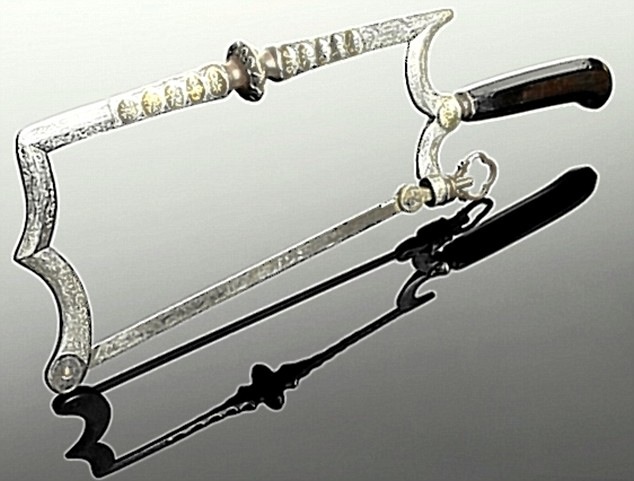
Removal Saw (the 1600s) While a few specialists paraded their riches with extravagantly designed saws this way, the hole in the mind-boggling inscriptions ended up being a rearing ground for germs.
3. Bolt Remover
Bolt Remover (the 1500s) was another scary tool out of the scary old surgical tools. Not much is thought about this device, however, it is conjectured that it was embedded into the injury in a contracted position, with the focal shaft used to get a handle on the bolt. The edges, which seem to have their sharp edges confronting outward, were then extended utilizing the scissor-like handles, in this manner growing the tissue around the bolt to keep the sharpened stone from tearing through the meat as it was hauled out.
4. Simulated Leech
Scary old surgical tools also include the Simulated Leech (1800s). Bloodletting with leeches was such a famous treatment for a scope of medical conditions that a fake bloodsucker was created in 1840 and was also utilized every now and again in the eye and ear surgery. The turning sharp edges would cut an injury in the patient’s skin, while the barrel would be utilized to create a vacuum that sucked up the blood.
5. Shot Extractor

Shot Extractor (the 1500s) Elongated slug extractors could achieve projectiles implanted profoundly in the patient’s body. Extractors like this one had a screw tip that could be embedded in the injury and stretched to penetrate the projectile so it could be hauled out.
6. Cervical Dilator
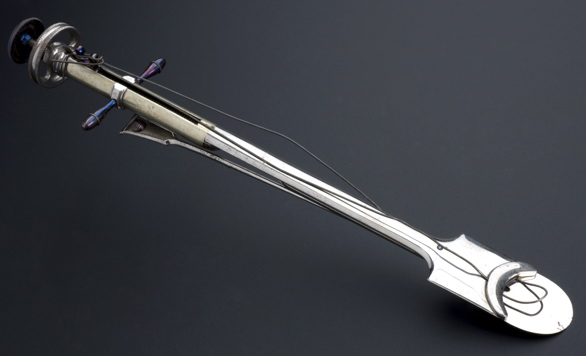
Cervical Dilator (the 1800s) This instrument was utilized to expand a lady’s cervix amid work, with the measure of widening measured on the scale by the handle. Such dilators dropped out of support since they frequently made the cervix tear.
7. Circumcision Knife

Circumcision Knife (the 1770s) Ritual circumcision is performed far and wide in shifting degrees and for differing reasons, yet few instruments utilized as a part of the procedure are scary because of this European blade which from the eighteenth century.
8. Ecraseur
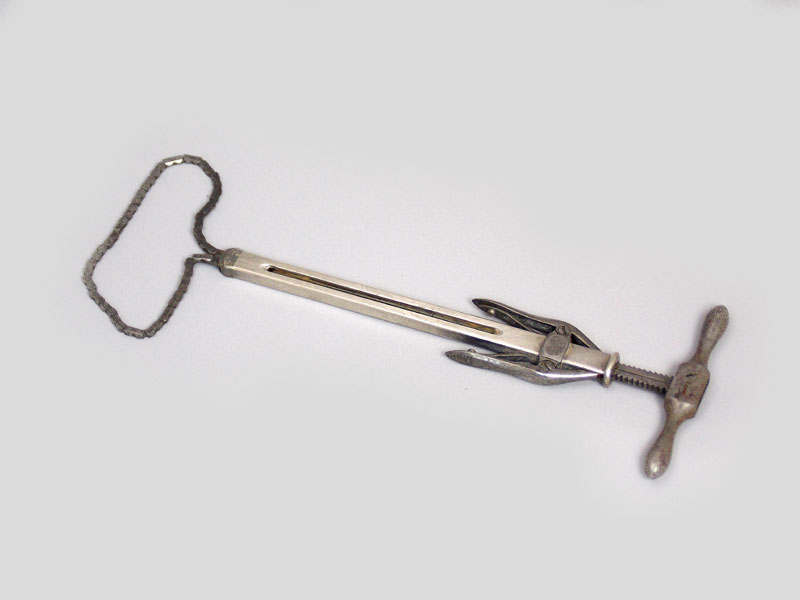
Ecraseur (the 1870s) This ecraseur was utilized to disjoin hemorrhoids and uterine or ovarian tumors. The chain was circled over the mass and also fixed to utilize the ratchet, ceasing the dissemination of blood to the zone.
9. Hemorrhoid Forceps

Hemorrhoid Forceps (the 1800s) also belongs to the list of scary old surgical tools. These forceps were utilized to get a handle on hemorrhoid between the sharp edges and apply weight to stop the blood supply, hence making hemorrhoid drop off.
10. Hernia Tool
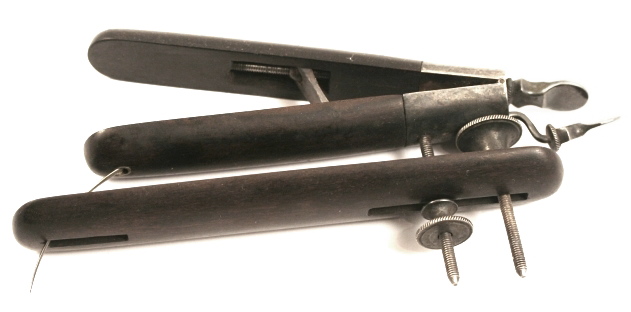
Hernia Tool (1850s) This one of a kind apparatus was utilized after the rebuilding of a hernia. It was embedded into the body close to the influenced range and left there for seven days so as to deliver scar tissue that would help close a hernia.
11. Hirtz Compass
Hirtz Compass (1915) The Hirtz compass was utilized to precisely figure out where projectiles were situated in the body so they could then be evacuated with accuracy.
12. Hysterotome

Hysterotome/Metronome (1860s-90s) This hysterotome or metrotome was utilized to cut away the cervix amid a hysterectomy. Thus, it is definitely one of the scary old surgical tools.
13. Lithotome
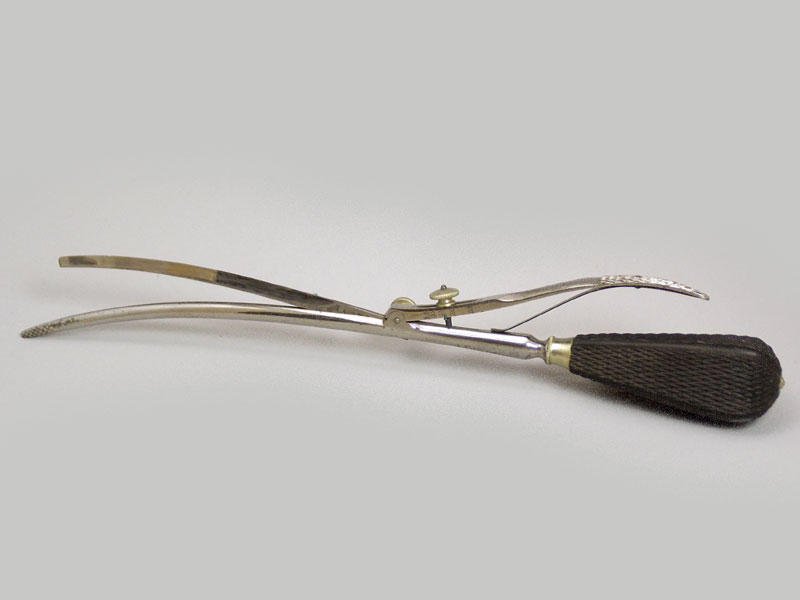
Lithotome (1740s-1830s) This lithotome was utilized to slice the bladder by also keeping in mind about the end goal to evacuate stones. The poll contained a concealed sharp edge that was embedded into the bladder and afterward discharged utilizing a spring handle.
14. Mouth Gag
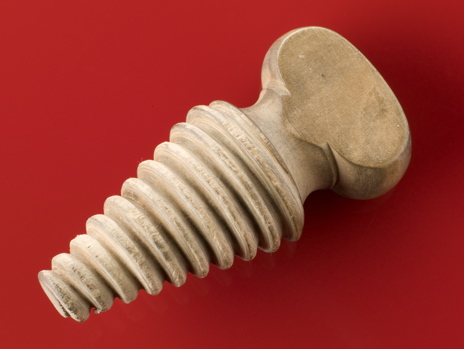
Mouth Gag (1880s-1910s) This wooden, screw-formed mouth muffle could be embedded into an anesthetized patient’s mouth so that it would keep the aviation route open.
15. Scarificator

Scarificator (1910s-20s) Scarificators were utilized as a part of phlebotomy. The name itself adds this to the list of scary old surgical tools. The spring-stacked cutting edges in this gadget would cut into the skin so that an extraordinary adjusted glass container could be connected to the injury. Whenever warmed, it would help draw the blood out at a speedier rate.
16. Skull Saw
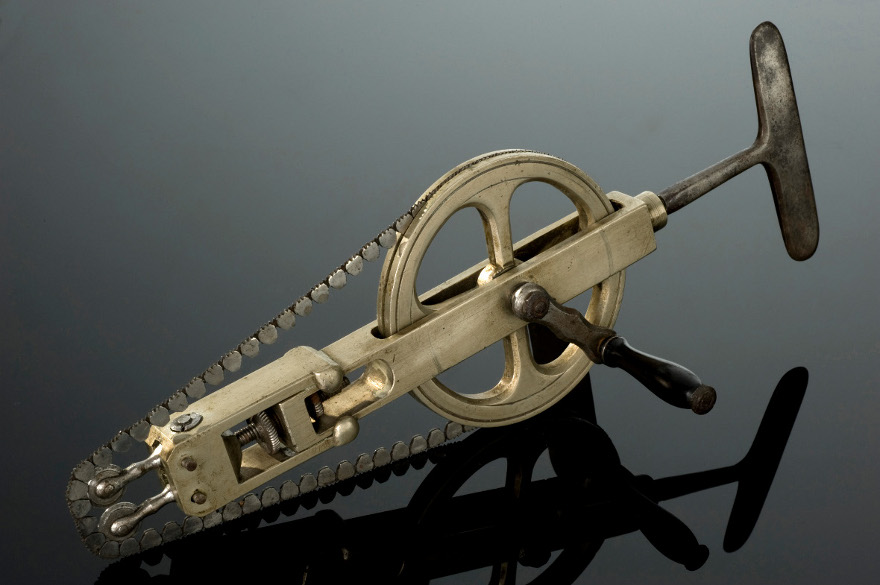
Skull Saw (1830s-60s) This hand-turned saw’s edges were utilized to slice through areas of the skull while taking into consideration of access by different instruments. Therefore, it is definitely one of the most scary old surgical tools.
17. Tobacco Smoke Enema
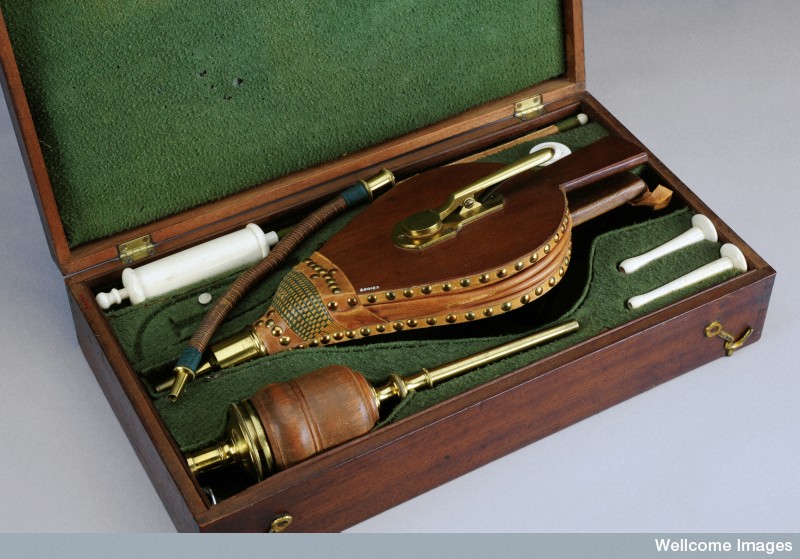
Tobacco Smoke Enema (1750s-1810s) The tobacco douche was utilized to implant tobacco smoke into a patient’s rectum for different medicinal purposes, while it was essentially used for the revival of suffocating casualties. A rectal tube embedded into the rear-end was associated with a fumigator and howls which consequently constrained the smoke towards the rectum. The glow of the smoke was thought to advance breath but yet questions about the validity of tobacco bowel purges prompted the prevalent expression “explode smoke one’s rear end.”
18. Tonsil Guillotine
Tonsil Guillotine (the 1860s) is another tool in the list of scary old surgical tools. This strategy for expelling tonsils worked pretty much like a customary guillotine, cutting off the contaminated tonsils. This “twofold guillotine” outline implied that the two tonsils could be expelled in the meantime. Tonsil guillotines were supplanted in the mid-twentieth century because of the high rate of draining and the loose idea of the gadget, which frequently left tonsil remainders in the mouth.
19. Trephine

Trephine (the 1800s) This trephine was a hand-controlled penetrate with a round and hollow edge that was utilized to drill into the skull. It was also used to remove a circle of bone or tissue. And, the spike in the inside was utilized to begin the strategy and to hold the edge set up while cutting.
20. Vaginal Speculum

Lastly, we have Vaginal speculum in our list of scary old surgical tools. Vaginal Speculum (the 1600s) Specula have been utilized for a huge number of years since they permit specialists better vision and access to the vaginal zone (or other body holes) by extending after inclusion. This seventeenth-century European case, which seems to utilize a wrenching movement to extend, is more lavish and threatening than most.
You may also like the following posts:
Dick Click: Turn ‘Off’ Your Semen With A Switch
Mental Disorders That Will Blow Your Mind
Euthanasia- A boon or a bane?
Like us on Facebook
Follow us on Instagram